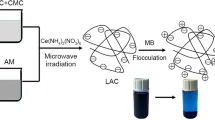Abstract
The removal of hazardous dyes from process water has become one of the most important tasks for water clarification. In this work, a novel type of latex, prepared by the emulsion polymerization of butyl acrylate (BA) and acrylamide (AM) in the presence of hemicellulose, was developed. Under the optimal polymerization conditions, the conversion of monomers reached as high as 97.6 %. The resulting hemicellulose-containing latex (HCL) was assessed as an absorbent toward dyes, methylene blue (MB) in particular. Much effort was made to revealing the impact of adsorption conditions of the dye removal induced by HCL. The maximum removal of the dye by HCL was about 93.8 %, much higher than that of the control sample. The dye adsorption isotherm was determined to further understand the adsorption mechanism. The adsorption data were found to fit Langmuir model well (R 2=0.99904). The maximum adsorption capacity obtained at 25 °C was 42.7 mg g−1, suggesting that the HCL is promising as an excellent absorbent for the removal of dyes from effluents.









Similar content being viewed by others
References
Sun RC, Lawther JM, Banks WB (1996) Fractional and structural characterization of wheat straw hemicelluloses. Carbohydr Polym 29:325–331
Ren JL, Xu F, Sun RC, Peng B, Sun JX (2008) Studies of the lauroylation of wheat straw hemicelluloses under heating. J Agric Food Chem 56:1251–1258
Goksu EI, Karamanlioglu M, Bakir U, Yilmaz L, Yilmazer U (2007) Production and characterization of films from cotton stalk xylan. J Agric Food Chem 55:10685–10691
Lindblad MS, Ranucci E, Albertsson AC (2001) Biodegradable polymers from renewable sources. New hemicellulose-based hydrogels. Macromol Rapid Commun 22:962–967
Tan IAW, Hameed BH, Ahmad AL (2007) Equilibrium and kinetic studies on basic dye adsorption by oil palm fibre activated carbon. Chem Eng J 127:111–119
Al-Qodah Z (2000) Adsorption of dyes using shale oil ash. Water Res 34:4295–4303
Lee JW, Choi SP, Thiruvenkatachari R, Shim WG, Moon H (2006) Evaluation of the performance of adsorption and coagulation processes for the maximum removal of reactive dyes. Dyes Pigments 69:196–203
Sheng JW, Xie YA, Zhou Y (2009) Adsorption of methylene blue from aqueous solution on pyrophyllite. Appl Clay Sci 46:422–424
Aksu Z (2005) Application of biosorption for the removal of organic pollutants: a review. Process Biochem 40:997–1026
Wang SB, Zhu ZH (2006) Characterisation and environmental application of an Australian natural zeolite for basic dye removal from aqueous solution. J Hazard Mater 136:946–952
Lee JW, Choi SP, Thiruvenkatachari R, Shim WG, Moon H (2006) Submerged microfiltration membrane coupled with alum coagulation/powdered activated carbon adsorption for complete decolorization of reactive dyes. Water Res 40:435–444
Hameed BH, Din ATM, Ahmad AL (2007) Adsorption of methylene blue onto bamboo-based activated carbon: kinetics and equilibrium studies. J Hazard Mater 141:819–825
Senthilkumaar S, Varadarajan PR, Porkodi K, Subbhuraam C (2005) Adsorption of methylene blue onto jute fiber carbon: kinetics and equilibrium studies. J Colloid Interface Sci 284:78–82
Hong S, Wen C, He J, Gan FX, Ho YS (2009) Adsorption thermodynamics of methylene blue onto bentonite. J Hazard Mater 167:630–633
Pagga U, Taeger K (1994) Development of a method for adsorption of dyestuffs on activated-sludge. Water Res 28:1051–1057
Wang KY, Furney TD, Hawley MC (1995) Modeling the Hf adsorption process on wood chips in a packed-bed reactor. Chem Eng Sci 50:2883–2897
Yao Y, Xu F, Zhu Z, Xu Z, Chen M (2010) Adsorption of methyl violet onto multi-walled carbon nanotubes: equilibrium, kinetics and modeling. Fresenius Environ Bull 19:854–861
Nassar MM, Magdy YH (1997) Removal of different basic dyes from aqueous solutions by adsorption on palm-fruit bunch particles. Chem Eng J 66:223–226
Wu GW, Koliadima A, Her YS, Matijevic E (1997) Adsorption of dyes on nanosize modified silica particles. J Colloid Interface Sci 195:222–228
Liu ZH, Ni YH, Fatehi P, Saeed A (2011) Isolation and cationization of hemicelluloses from pre-hydrolysis liquor of kraft-based dissolving pulp production process. Biomass Bioenerg 35:1789–1796
Langmuir I (1918) The adsorption of gases on plane surfaces of glass, mica and platinum. J Am Chem Soc 40:1361–1403
Atia AA, Donia AM, Al-Amrani WA (2009) Adsorption/desorption behavior of acid orange 10 on magnetic silica modified with amine groups. Chem Eng J 150:55–62
Weber TW, Chakravo Rk (1974) Pore and solid diffusion models for fixed-bed adsorbers. AIChE J 20:228–238
Krajewski A, Piancastelli A, Malavolti R (1998) Albumin adhesion on ceramics and correlation with their Z-potential. Biomaterials 19:637–641
Drzymala J, Sadowski Z, Holysz L, Chibowski E (1999) Ice/water interface: zeta potential, point of zero charge, and hydrophobicity. J Colloid Interf Sci 220:229–234
Acknowledgements
Authors are grateful to Atlantic Innovation Fund (AIF), Innovative Green Wood Fibre Products—NSERC Strategic Network (Canada), NSF China (No. 31200456 and No. 51379077) and program for high school excellent talent of Liaoning Province China (No. LJQ2013060) for funding.
Author information
Authors and Affiliations
Corresponding author
Rights and permissions
About this article
Cite this article
Zhang, J., Xiao, H. & Yang, Y. Preparation of hemicellulose-containing latex and its application as absorbent toward dyes. J Mater Sci 50, 1673–1678 (2015). https://doi.org/10.1007/s10853-014-8728-8
Received:
Accepted:
Published:
Issue Date:
DOI: https://doi.org/10.1007/s10853-014-8728-8




